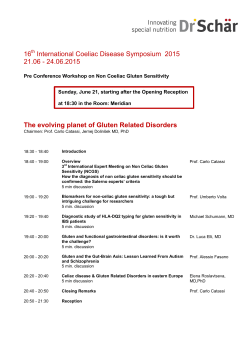
analytical validation of an enzime-linked immunosorbent
ANALYTICAL VALIDATION OF AN
ENZIME-LINKED
IMMUNOSORBENT ASSAY FOR
THE DETERMINATION OF GLUTEN
Jovana J. Matić 1*, Anamarija I. Mandić 1, Bojana M.
Beljkaš1, Ivan LJ. Milovanović 1, Pavle T. Jovanov1
UDC 664.336 : 543.632 : 577.15
1
Institute for Food Technology, Novi Sad, Serbia
Abstract: Gluten is a protein from cereals, which may cause intolerance on food, and can provoke celiac disease.
As a routine, gluten is usually conventionally analyzed by enzyme-linked immunosorbent assay method (ELISA).
In-house validation of the ELISA screening method for gluten determination was the aim of this work. As certified
reference material of gluten is not available, validation was done with spiked samples of gluten free mixture for
bread and bakery products and baby food. Validation parameters described in this paper include repaeatability,
intra-laboratory reproducibility and accuracy. Uncertainity was calculated from data obtained during validation. The
obtained results show that the ELISA method can be used as a screening method for the analysis of gluten in
gluten-free products.
Key words: Gluten, Gluten-free products, Baby food, ELISA, Method validation, Uncertainty
INTRODUCTION
Gluten represents the main water-insoluble
protein fraction in several cereals such as
wheat, rye, oats and barley. Due to the
occurence of especially these amino acids
in the gluten molecule, this protein can
provoke celiac disease (Iametti et al.,
2004). Celiac disease is a chronic inflammatory disease of the gastrointestinal
tract triggered by dietary gluten in susceptible induviduals. Common symptoms of
celiac disease are poor absorbtion of nutrients in the small intestine, fatigue, weight
*Corresponding author:
e-mail: jovana.matic@fins.uns.ac.rs:
Tel: +381 21 485 3829: Fax: +381 21 450725
loss and generally poor health. Complete
and lifelong adherence to a gluten-free diet
is the only accepted tretment which allows
patients to lead an otherwise normal life
(Sugai et al., 2009). About 0.5-1% of the
Western population suffers from celiac
disease, which makes it one of the most
common food sensitivities worldwide (Van
den Broeck et al., 2009). According to
unofficial statistical data about 0.44-0.92%
of the population in Serbia suffers from celiac disease (www.pks.rs).
Matić , J. et al., Analytical validation of an enzyme-linked immunosorbent assay for the determination of gluten,
Food Processing, Quality and Safety 4(2008) 183-188
According to the Codex Alimentarius recommendations (ALINORM, 08/31/26, Apendix III) and Comission Regulation (EC, No
41/2009) foods labelled as gluten-free must
not exceed 20 mg/kg of gluten in food. The
food producers in the European Union have
to comply with the regulation of Directive
2000/13/EC, as amended by Directive,
2003/89/EC with regard to indication of
allergenic ingredients present in foodstuffs.
By regulations in Serbia ("Sl. glasnik RS",
br. 35/2008) gluten level in gluten-free products also must not exceed 20 mg/kg. Products declared as a gluten-free should not
contain wheat, rye, barley and oat, or if they
contain these cereals, gluten must be removed by special treatman in order to
achieve the concentration level outlined in
regulations.
Methods for determining the content of gluten in foodstuffs include enzyme-linked
immunosorbent assay (ELISA) (Iametti et
al., 2004), High Performance Liquid Chromatography (Wieser et al., 1998.) and
electrophoretic methods (Restani et al.,
2002). As a routine analysis, gluten is most
conveniently analyzed by ELISA tests
(Denery-Papini et al., 1999). Gluten proteins are comprised of monomeric gliadins
and polymeric glutenins, which are present
in approximately equal amounts (Osborne,
1907). Therefore, the content of gluten in
food products is usually calculated from the
gliadin content.
Due to necessity of the gluten control in
gluten-free food products, in-house validation of the ELISA screening method was the
aim of this work. As certified reference material of gluten is not available, validation
was done on spiked samples of gluten free
mixture for bread and bakery products and
baby food. The following validation parameters were determined: repaeatibility, intralaboratory reproducibility and accuracy.
Uncertainity was calculated from data obtained during validation.
MATERIALS AND METHODS
Two different types of samples, gluten-free
mixture for bread and bakery products (gluten-free mixture) and baby food, were used
for determination of validation parameters.
Both samples were declared as the glutenfree products.
Due to lack of gluten certified reference material (CRM), it was necessary to prepare
spiked gluten-free samples. Huber (2007)
reported that if CRM or control samples are
not available, a blank sample matrix of
interest can be spiked with a known concentration. The aim of spiking was to obtain
content of gluten in finally samples of
approximately 20 mg/kg, which is the maximum tolerable level in products declared
as gluten-free.
Spiking procedure for gluten-free
mixture
Gluten-free mixture was spiked with wheat
flour. Content of gluten in wheat flour was
15.3 mg/kg, after dilution with ethanol.
Spiking was done by the following procedure: gluten-free mixture and wheat flour
were mixed in ratio of 9:1 (w/w); further
dillution was 99:1(w/w); and finally this
mixture was diluted ten times with glutenfree mixture. Each step of listed procedure
was performed with constant stirring.
Spiking procedure for baby food
Concentration of gliadin standard, used as
a spike for baby food, was 10.4 mg/kg
(determined by six repetitions), which corresponds to the 20.8 mg/kg concentration
of gluten. After an adequate sample preparation and dilution with phosphate saline
buffer, 75 µl of sample and 75 µl of gluten
standard (c=20.80 mg/kg ) was added to
the well.
Standard materials
Gliadin standard solutions (5,00; 10,00;
20,00 and 50,00 mg/kg) were used for the
preparation of calibration curves. Standards
and all reagents from Veratox test kits were
stored at 2-8 °C and were warmed to room
temperature before use.
ELISA method
The gluten content in the samples was
measured by using a commercial Gliadin
ELISA kit (Veratox®, Neogen). Veratox for
gliadin is a sandwich enyzme-linked immunesorbent assay. Gliadin is extracted from
samples with 40% ethanol solution by shaking in a shaker. Extract is diluted in phosphate saline buffer and diluted samples
are added to antibody-coated wells where
gliadin will bind to the antibody during an
incubation period. Any unbound gliadin is
Matić , J. et al., Analytical validation of an enzyme-linked immunosorbent assay for the determination of gluten,
Food Processing, Quality and Safety 4(2008) 183-188
washed away and a second antibody,
which is enzyme labeled is added. Unbound enzyme-labeled antibody is washed
away and a one step substrate is added.
Color develops as a result of the presence
of bound-labeled antibody. A stopping reagent is added and the color of the solution
is observed. Optical density is measured at
650 nm in a microwell reader (Thermolabsystem, Thermo, Finland). The optical
densities of the controls form the standard
curve, and the sample optical densities are
plotted against the curve to calculate the
exact concentration of gliadin. As approximately 50% of the gluten is available as
gliadin, concentration of gliadin multiply by
2 represents the gluten value of the samples (Veratox®, Neogen).
RESULTS AND DISCUSSION
The following validation parameters were
determined: repeatability, intra-laboratory
reproducibility and accuracy. The performance characteristics, limit of quantitation
and range of quantitation are recommended
by manufacturer (Veratox®, Neogen). The
limit of quantitation is 5 mg/kg, and this
value is described as the lowest concentration point on the calibration curve at
which the test can reliably detect gliadin.
The range of quantitation is 5-50 mg/kg of
gliadin.
For quantitative measurements, recombinant standards are provided to generate
calibration curves (Figure 1). Analysis of
standards and preparation of calibration
curves needs to be done every time when
samples are analyzed. The same standards
are used during validation.
Validation parameters
Figure 1. Calibration curve
Repeatability was evaluated under conditions where independent test results are obtained with the same method on identical
test items by the same operator using the
same equipment within short intervals of
time. Spiked samples of gluten-free mixture
and baby food were analysed in three repetitions for the calculation of the repeatability.
Intra-laboratory reproducibility was determined from measurement of three samples
in various time intervals. Spiked samples
were analysed three times and results were
measured in three different time periods (0,
15 and 30 minutes).
The accuracy of an analytical method can
be described as the closeness of agreement between the true and the value found.
The recovery was assessed by adding a
known amount of a wheat flour to a glutenfree mixture and gliadin standards solution
to a gluten-free baby food.
Repeatability and intra-laboratory reproducibility, expressed by standard deviation
and relative standard deviation, and recovery for gluten-free mixture are shown in
the Table 1.
Matić , J. et al., Analytical validation of an enzyme-linked immunosorbent assay for the determination of gluten,
Food Processing, Quality and Safety 4(2008) 183-188
Table 1.
Validation parameters for gluten-free mixture for bread and bakery products
Gluten-free mixture for bread and bakery products
Repeatability
Gluten (mg/kg)
Sr (%)
RSDr (%)
Intralaboratory reproducibility
18.6
3.26
24.6
Gluten (mg/kg)
SR (%)
RSDR (%)
From the results it can be noticed that unusually high standard deviation and relative
standard deviation for repeatability and
intra-laboratory reproducibility were obtained by analysis of the gluten-free mixture. These results can be explained by inability to prepare adequate homogeneous
spiked samples. For the preparation of
spiked samples two solid sample were used
(gluten-free mixture and wheat flour), and
therefore adequate homogeneity of the
sample was not achieved. The expected recovery for average concentration of gluten
18.7
2.94
22.1
Recovery (%)
87.1
18.7 mg/kg is between 80 and 110%
(AOAC, 1998). The obtained recovery of
87.1% is in accordance with this standard.
High standard deviations and relative standard deviations are also commonly found
during routine laboratory analyses of powdered and solid samples. The reason for
this is that gluten is usually not evenly
distributed in the whole mass of such samples.
Sumarized results of validation for baby
food are shown in Table 2.
Table 2.
Validation parameters for baby food
Baby food
Repeatability
Intralaboratory reproducibility
Gluten (mg/kg)
Sr (%)
13.2
1.07
Gluten (mg/kg)
SR (%)
13.3
1.05
RSDr (%)
5.73
RSDR (%)
5.61
Analysis of spiked baby food samples were
showed lower values of standard and
relative standard deviation than the spiked
gluten-free mixture. The values of relative
standard deviation for repeatibility and intralaboratory reproducibility are in accordance
with the prescribed range of 5.3-7.3%, as
also value of recovery between 80 and
110% (AOAC, 1998).
Uncertainty
The uncertainty of measurement is the major unifying principle for data quality. The
definition by ISO is that the uncertainty is
the parameter, associated with the result of
a measurement, that characterizes the dispersion of the values that could reasonably
be attributed to the measurand (Gum,
1993).
The uncertainty was calculated according to
the instructions of Magnusson et al. (2004).
The Bias is difference between mean
Recovery (%)
93.6
measured value from a series of test results
and an accepted value. The u(bias) is
uncertainty component for bias, and this
value is always included in the measurement uncertainty calculations.
For every estimation of the uncertainty from
the method and laboratory bias, two components have to be estimated to obtain
u(bias): the bias and the uncertainty of the
nominal value, u(ref).
The uncertainty of the bias, u(bias) can be
estimated by the following equation:
where
Matić , J. et al., Analytical validation of an enzyme-linked immunosorbent assay for the determination of gluten,
Food Processing, Quality and Safety 4(2008) 183-188
and
And finally expanded (U) uncertainty was
calculated using the following equation:
Rw is intermediate precision which means
that operator and/or equipment and/or time
and/or calibration can be varied, but in the
same laboratory.
The reason for calculating the expanded
uncertainty is to reach a high enough confidence that the true value lies within the
interval given by the measurement result ±
the uncertainty.
Combined standard (uc) uncertainties can
be summed by taking the square root of the
sum of the squares.
The parameters of uncertainty for the gluten-free mixture and baby food are shown
in the Table 3.
Table 3.
The parameters of uncertainity for gluten-free mixture and baby food
Parameters of uncertainty
Gluten-free mixture
Baby food
Bias
u(bias)
RMSbias
u(ref)
u(Rw)
uc
U (%)
104.4
4.17
8.24
0.98
4.28
9.29
18.6
23.6
1.98
2.94
0.35
2.01
3.56
7.12
From the obtained uncertainity results it can
be concluded that the expanded uncertainity for gluten-free mixture of 18.6% is
much greater than 7.12% for baby food.
These differences can be explained with
inadequately homogeneity of spiked glutenfree mixture samples.
CONCLUSION
From the obtained results it could be concluded that the ELISA method is adequate
for the analysis of gluten in gluten-free
products and meets the requirements of
validation and quality control purposed for
the screening methods.
ACKNOWLEDGEMENTS
This work was supported by the Project No
TR-20066, Ministry of Science and Technological Development, Republic of Serbia.
REFERENCES
1.
AOAC Peer-Verified Methods Program,
(1998). Manual on policies and procedures,
Arlington, Va., USA
2.
Codex Alimentarius Commission, Report of
the 27th Session of the Codex Committee
on Methods of Analysis and Sampling, ALINORM 06/29/23.
3.
Codex Alimentarius Commission, Report of
th
the 29 Session of the Codex Committee on
Nutrition and Foods for Special Dietary
Uses, ALINORM 08/31/26, Appendix III.
4. Commission Regulation EC No 41/2009
concerning the composition and labelling of
foodstuffs suitable for people intolerant to
gluten, Official Journal of the European Union.
5. Directive 2003/89/EC of the european parliament (amending 2000/13/EC) as regards
indication of the ingredients present in foodstuffs.
6. Denery-Papini, S., Nicolas, Y., Popineau, Y.
(1999). Efficiency and limitations of immunechemical assays for the testing of glutenfree foods, Journal of Cereal Science, 30,
124-131.
7. Guide to the Expression of Uncertainty in
Measurement, (1993). International Organization for Standardization.
8. Huber, L. (2007) Validation and Qualification in Analytical Laboratories. New York:
Informa Healthcare USA.
9. Iametti, S., Cappelletti, C., Oldani, A., Scafuri, L., Bonomi, F. (2004). Improved protocols for ELISA determination of gliadin in
glycose syrups, Cereal Chemistry, 81 (1),
15-18.
10. Magnusson, B., Näykki, T., Hovind, H.,
Krysell, M. (2004). Handbook for calculation
of measurement uncertainty in environmental laboratories, Edition 2, Nordest Tekniikantie, Finland.
Matić , J. et al., Analytical validation of an enzyme-linked immunosorbent assay for the determination of gluten,
Food Processing, Quality and Safety 4(2008) 183-188
®
11. Neogen Veratox , Quantitative Gliadin Test,
Product #8480.
12. Osborne, T.B., (1907). The protein of the
wheat kernel, Publication of Carnegie Institution of Washington, No. 84.
13. Pravilnik o uslovima u pogledu zdravstvene
ispravnosti dijetetskih namirnica koje se
mogu stavljati u promet ("Sl. list SFRJ", br.
4/85, 70/86 i 69/91, "Sl. list SCG", br.
56/2003 - dr. pravilnik i "Sl. glasnik RS", br.
35/2008)
14. Restani, P., Beretta, B., Ballabio, C., Galli,
C., Berttelli, A. (2002). Evaluation by SDSPAGE and immunoblotting of residual
antigenicity in gluten-treated wine: A preliminary study, 24 (2), 45-51.
15. Sugai, E., Nachman, F., Vaquez, H., Gonzalez, A., Andrenacci, P., Czech, A., Niveloni, S., Mazure, R., Smecuol, E., Cabamme, A., Maurino, E., Bai, J. (2009). Dynamics of celiac disease-specific serology
after initiation of a gluten-free diet and use in
the assessment of compliance with treatment, Digestive and Liver Disease, in press.
16. Van den Broeck, H., America, A., Smulders,
M., Bosch, D., Hamer, R., Gilissen, L., Van
der Meer, I. (2009). A modified extraction
protocol enables detection and quantification
of celiac disease-related gluten proteins
from wheat, Journal of Chomatography B,
877, 975-982.
17. Wieser, H., Antes, S., Seilmeier, W. (1998).
Quatitative determination of gluten protein
types in wheat flour by reversed-phase highperformance liquid chromatography, Cereal
Chemistry, 75(5), 644-650.
18. www.pks.rs
© Copyright 2025









